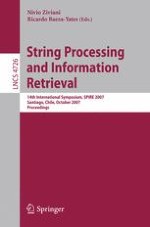2007 | Buch
String Processing and Information Retrieval
14th International Symposium, SPIRE 2007 Santiago, Chile, October 29-31, 2007 Proceedings
herausgegeben von: Nivio Ziviani, Ricardo Baeza-Yates
Verlag: Springer Berlin Heidelberg
Buchreihe : Lecture Notes in Computer Science
